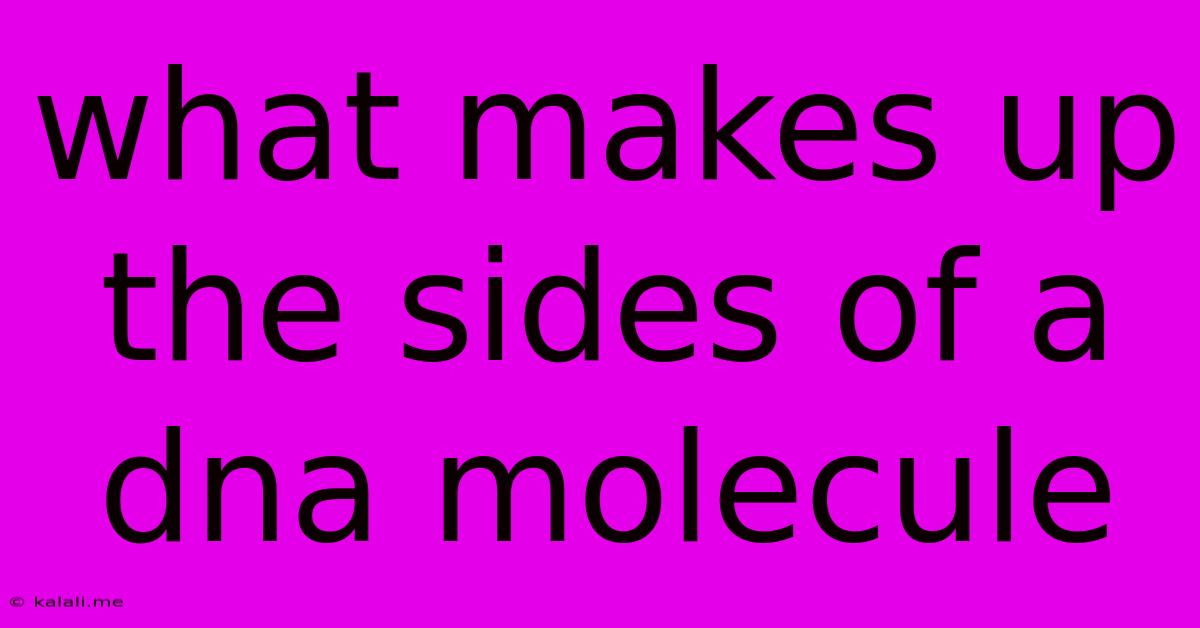What Makes Up The Sides Of A Dna Molecule
Kalali
May 10, 2025 · 3 min read

Table of Contents
What Makes Up the Sides of a DNA Molecule? The Sugar-Phosphate Backbone Explained
DNA, the blueprint of life, is a remarkably elegant molecule. Its iconic double helix structure is instantly recognizable, but understanding what actually forms the sides of this helix is key to grasping its function. This article delves into the composition of the DNA backbone, explaining the roles of sugar and phosphate groups in its stability and functionality.
The sides of a DNA molecule are formed by a sugar-phosphate backbone. This backbone is a crucial structural element, providing the framework upon which the genetic information – the base pairs – is arranged. It's not just a passive scaffold, though; its properties are integral to DNA's stability and the processes of replication and transcription.
Deoxyribose Sugar: The Sweet Foundation
The "deoxyribose" part of the name is a clue to the backbone's composition. Deoxyribose is a pentose sugar – a five-carbon sugar – that forms the structural core of each strand. Specifically, it's a deoxyribose because it lacks an oxygen atom on the 2' carbon compared to ribose, the sugar found in RNA. This seemingly small difference is crucial for DNA's stability. The absence of the 2'-hydroxyl group makes DNA less reactive and more resistant to hydrolysis (breakdown by water), making it a more stable molecule suitable for long-term storage of genetic information.
Each deoxyribose sugar molecule within the backbone is linked to the next via phosphate groups, creating the sugar-phosphate chain. The numbering of the carbon atoms in the deoxyribose (1', 2', 3', 4', 5') is critical for understanding the linkage.
Phosphate Groups: Linking the Sugars
Phosphate groups are negatively charged ions (PO43−). Their presence is what gives the backbone its characteristic negative charge. This negative charge is incredibly important:
- Solubility: It contributes to the DNA's solubility in water, allowing it to interact with the aqueous environment within the cell.
- Stability: The electrostatic repulsion between the negatively charged phosphate groups helps to keep the two DNA strands separated, preventing them from collapsing into a single strand.
- Enzyme Interactions: Many enzymes involved in DNA replication and transcription interact with the negatively charged backbone, recognizing and binding to specific sites for facilitating these critical processes.
The phosphate group forms a phosphodiester bond, linking the 3' carbon of one deoxyribose sugar to the 5' carbon of the next deoxyribose sugar. This 3'-5' phosphodiester bond creates a directional backbone, contributing to the polarity of each DNA strand (5' to 3'). This directionality is crucial for DNA replication and transcription as enzymes involved in these processes read the DNA sequence only in a specific direction.
The Complete Picture: A Strong and Stable Structure
The sugar-phosphate backbone, therefore, isn't just a simple chain; it's a complex, highly organized structure with specific chemical properties that are essential for DNA's function. Its stability ensures that the genetic information encoded within the base pairs is safely preserved and passed on. Its negative charge facilitates interactions with proteins and other molecules critical for DNA processes. Understanding the details of this backbone is foundational to appreciating the complexity and elegance of the DNA molecule itself.
Latest Posts
Latest Posts
-
How Much Is Three Quarts Of Water
Jul 03, 2025
-
How Tall Is A 3 Story Building
Jul 03, 2025
-
Is Miranda Cosgrove Related To Jimmy Fallon
Jul 03, 2025
-
What Is 1 4 Of A 1 4 Cup
Jul 03, 2025
-
What Is 20 Percent Off Of 39 99
Jul 03, 2025
Related Post
Thank you for visiting our website which covers about What Makes Up The Sides Of A Dna Molecule . We hope the information provided has been useful to you. Feel free to contact us if you have any questions or need further assistance. See you next time and don't miss to bookmark.